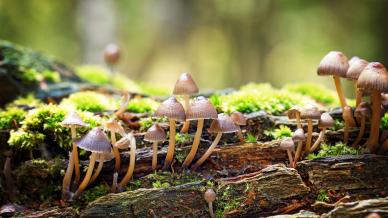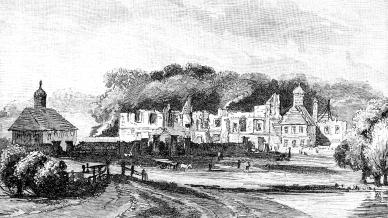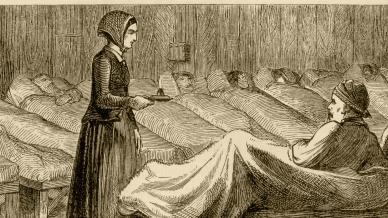Why are some fungi brightly coloured and others appear drab? It’s not a joke or a trick question. If you have the answer, then please write in! It’s one of nature’s codes that biologists still haven’t cracked. Despite the extraordinary progress in mycology, there is much we don’t know about the fascinating world of fungi.
Happily, there’s also plenty we do know about this shady subject. Fungi are all around us in everyday life. Of course, there are the sanitised button, oyster or shiitake mushrooms, stacked up in supermarket tubs, as well as seasonal varieties such as chantarelles, morels and expensive truffles. We rely on fungi for bread, blue cheese and beer – three staples of a Ploughman’s Lunch. Important medicines are produced by fungi, most famously the penicillium mould, which has saved millions of lives since Alexander Fleming discovered its antibiotic qualities in 1928.
If you ask someone to draw fungi, they’ll likely sketch the familiar cap and stalk of a field mushroom or fairy tale toadstool, or perhaps a thick wedge shape clinging to a tree. In fact, these are simply the fruit of the fungi, similar to an apple or gooseberry. If you pick (or tread on) them, then the rest of the fungi will largely carry on as before.
Dial M for Mushroom
The real body of the fungi is made up of thin strands of hyphae that wind together beneath the surface to form mycelium, which can appear like cotton wool if you scrape rotting leaf litter. These mycelia spread and intertwine, sometimes over great distances, and will wrap around the roots of trees and even live within the roots themselves. Aside from tree roots, 90 percent of all living matter in forest soil is made up of fungi.
What’s going on? It all comes down to food. Unlike plants that photosynthesise, fungi don’t produce food on their own, so they need to get their energy from other sources. There are broadly three types of feeder. Saprophytes break down dead or rotting wood, or even dead animals. Parasitic fungi dine directly off living parts of plants – such as the honey fungus, which can destroy many trees in a local area. (The old joke is that the best way to get rid of honey fungus is to move house.)
The third type are called mycorrhizas. These are the fungi that wrap around the roots of trees. They form a symbiotic relationship: the fungi provide nutrients to the trees and receive sugars in return. But here’s where it gets really interesting. It’s not just vital resources that they’re swapping. Scientists have discovered that trees use this underground, super-fast broadband of natural fibres – coined the wood-wide web – to communicate with one another.
What Sap?
Extraordinary findings suggest that ‘mother trees’ will use the network to nurture shaded seedlings, providing them with nutrients to give them a better chance of survival. Trees send high-priority emails to their neighbours, when they are attacked by an aphid or parasite, giving them advance warning to raise their defences. It’s even believed that a dying tree will channel its last nutrients across the network to friends and family, as a final, sacrificial bestowal.
It's not all feelgood and fluffy. Just like our own Internet, there are malevolent forces at work, spreading disinformation and fake news. Certain species of orchid will hack the system to steal resources. Black Walnut trees send toxic chemicals through the dark web to sabotage their rivals.
Of course, we must be wary about using anthropomorphisms such as intelligence and altruism. But the mycorrhizal networks are showing science a greater depth and sophistication to the natural world. What if trees are just the visible signs of a super-ecosystem, chatting and sharing resources underground? And given the importance of trees to carbon capture and storage, could the wood-wide web help us crack the code of climate action?
As somebody who has derived so much pleasure from studying, foraging and eating fungi, I heartily recommend it as a past-time for staying active and putting fresh, seasonal food on your plate. The Collins Complete Guide to British Mushrooms and Toadstools: A Photographic Guide to Every Common Species is an excellent companion to ensure you don’t fry up the wrong ones for breakfast. There is so much more to fungi when you dig beneath the surface.
Inspired? For more food for thought, why not become a member for £15 a year and enjoy our weekly online lectures.
















